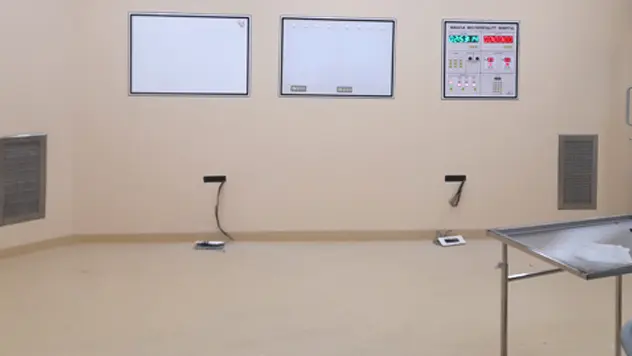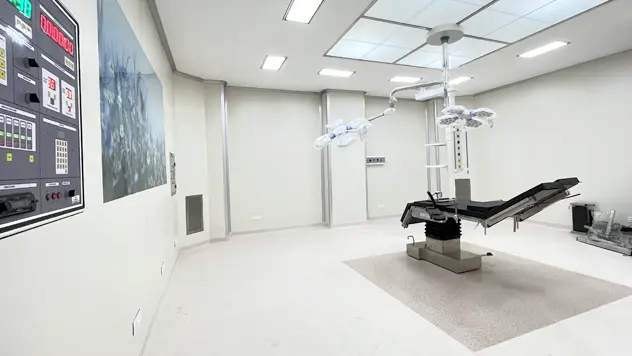MOT : Vinyl Flooring
Vinyl floors have stain resistant surface treatments enabling easy cleaning and guaranted hygiene.
Features:
- Reduces the spread of pathogens
- Easy to maintain
- Reduces sound impact
- Prevents bacterial/fungal growth
- Antimicrobial properties to inhibit the growth of bacteria and germs, promoting a hygienic environment.
- Slip-resistant surface to prevent accidents and ensure safety, especially in areas prone to spills and moisture.
- Easy to clean and maintain, allowing for efficient sanitation and upkeep of hospital spaces.
- Noise reduction capabilities to minimize sound transmission, creating a quieter environment for patients and staff.
- Resistance to stains and chemicals, ensuring durability and longevity even in high-traffic areas.
- Comfort underfoot for patients, visitors, and healthcare professionals, contributing to a more pleasant experience within the hospital.
- Compatibility with underfloor heating systems for enhanced comfort and temperature control.
- Eco-friendly materials and manufacturing processes to support sustainability efforts in healthcare facilities.
- Electrostatic Conductive Vinyl
- High Resistance against Chemical & Mechanical Strains
- Wide range of Colours
- Easy to Install, Repair, Clean
- High Resistance against Chemical & Mechanical Strains
- Wide range of Colours
Benefits
- Hygiene: Hospital vinyl flooring is often designed with antimicrobial properties, inhibiting the growth of bacteria and promoting a cleaner environment.
- Durability: Vinyl flooring is resilient and can withstand heavy foot traffic, equipment, and frequent cleaning without showing signs of wear and tear.
- Easy Maintenance: Hospital vinyl flooring is easy to clean and maintain, requiring minimal effort to keep it sanitary and looking new.
- Safety: Many hospital vinyl flooring options are slip-resistant, reducing the risk of slips and falls, especially in areas prone to spills or moisture.
- Noise Reduction: Vinyl flooring can help reduce noise levels in hospital settings, creating a quieter and more conducive environment for patients and staff.
- Comfort: Some vinyl flooring options offer cushioning and underfoot comfort, providing a more comfortable experience for patients and healthcare workers who spend long hours on their feet.
- Aesthetics: Hospital vinyl flooring comes in a variety of designs and colors, allowing for customization to match the décor and design preferences of different hospital areas.
- Cost-Effectiveness: Vinyl flooring is often more affordable compared to other flooring options, providing excellent value for money while still delivering on performance and durability.
Types
- Luxury Vinyl Tile (LVT): LVT closely resembles natural materials like wood or stone and is available in various designs and textures. It offers durability, water resistance, and easy maintenance.
- Vinyl Sheet Flooring: Vinyl sheet flooring comes in large rolls, making installation easier and reducing seams where dirt and moisture can accumulate. It provides a smooth, seamless surface that is easy to clean and maintain.
- Vinyl Composition Tile (VCT): VCT is a durable and economical option made of vinyl chips compressed into solid tiles. It is commonly used in commercial and institutional settings due to its durability and ease of maintenance.
- Homogeneous Vinyl Flooring: Homogeneous vinyl flooring is made of a single layer of vinyl, providing consistent color and pattern throughout the thickness of the material. It offers durability, ease of maintenance, and resistance to wear and tear.
- Heterogeneous Vinyl Flooring: Heterogeneous vinyl flooring consists of multiple layers, including a wear layer, printed design layer, and backing layer. It allows for greater design flexibility and can mimic the appearance of various natural materials.
- Each type of vinyl flooring has its own unique characteristics, making it suitable for different applications based on factors such as durability, design flexibility, ease of maintenance, and budget considerations.
Procedure of Installation
- Preparation: Clear the installation area of any furniture, fixtures, or debris. Ensure the subfloor is clean, dry, and level. If needed, perform any necessary repairs or adjustments to the subfloor.
- Acclimatization: Allow the vinyl flooring materials to acclimate to the installation environment as per the manufacturer’s recommendations. This usually involves storing the materials in the installation area for a specified period before installation.
- Measurement and Layout: Measure the installation area carefully and plan the layout of the vinyl flooring, considering factors such as room dimensions, doorways, and obstructions. Mark guidelines on the subfloor to guide the installation process.
- Cutting: Using appropriate tools such as a utility knife or vinyl cutter, cut the vinyl flooring materials to fit the dimensions of the installation area, ensuring precise cuts around obstacles like door frames and corners.
- Adhesive Application: Apply the recommended adhesive to the subfloor using a trowel, following the manufacturer’s instructions regarding coverage and application techniques. Allow the adhesive to set to the appropriate tackiness before laying the vinyl flooring.
- Installation: Carefully lay the vinyl flooring into place, starting from one corner of the room and working towards the opposite end. Press the flooring firmly into the adhesive, ensuring proper alignment and minimizing air bubbles or wrinkles.
- Seaming: If installing vinyl sheet flooring, join seams using heat-welding techniques or adhesive tape, ensuring a seamless appearance and strong bond between sections.
- Trimming: Trim any excess vinyl flooring material along the edges of the installation area using a utility knife or specialized trimming tool.
- Finishing: Install transition strips or moldings as needed to cover edges and transitions between different flooring surfaces. Clean the installed vinyl flooring thoroughly to remove any adhesive residue or debris.
- Quality Check: Inspect the installed vinyl flooring for any defects, imperfections, or areas requiring touch-ups. Make any necessary adjustments or repairs to ensure a high-quality finished installation.
- Final Inspection: Conduct a final inspection of the completed installation to ensure that it meets the desired specifications and standards for quality, safety, and appearance.
- Documentation: Maintain records of the installation process, including product warranties, maintenance instructions, and any relevant documentation for future
Recommended areas of use for vinyl flooring
- Hospitality Industry: Vinyl flooring is used in hotels, resorts, and other hospitality establishments due to its durability, aesthetic appeal, and ability to withstand high-traffic areas such as lobbies, hallways, and guest rooms.
- Healthcare Facilities: Vinyl flooring is ideal for hospitals, clinics, and medical offices because of its hygienic properties, slip resistance, and ability to withstand heavy foot traffic and frequent cleaning.
- Industrial Settings: Vinyl flooring is suitable for industrial environments such as factories, warehouses, and manufacturing facilities due to its durability, resistance to chemicals and oils, and ease of maintenance.
- Residential Spaces: Vinyl flooring is suitable for various rooms in homes, including living rooms, bedrooms, kitchens, and bathrooms.
- Commercial Settings: Vinyl flooring is commonly used in commercial spaces such as offices, retail stores, restaurants, and hotels due to its durability, easy maintenance, and wide range of design options.
- Educational Institutions: Vinyl flooring is suitable for schools, colleges, and universities due to its durability, easy maintenance, and ability to withstand high-traffic areas such as corridors and classrooms.
- Retail Spaces: Vinyl flooring is popular in retail environments such as shopping malls, boutiques, and supermarkets due to its durability, easy maintenance, and ability to create visually appealing displays.
- Sports Facilities: Vinyl flooring is used in sports facilities such as gymnasiums, fitness centres, and indoor sports courts due to its shock absorption, slip resistance, and durability.



